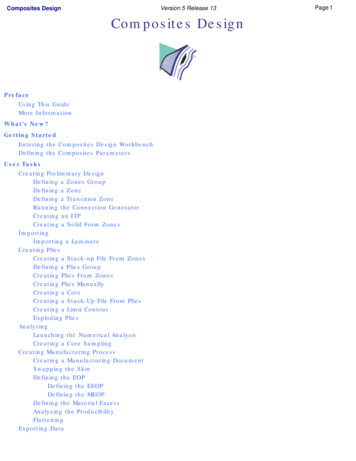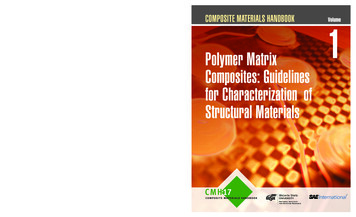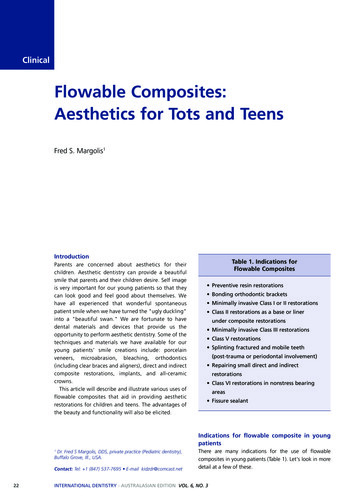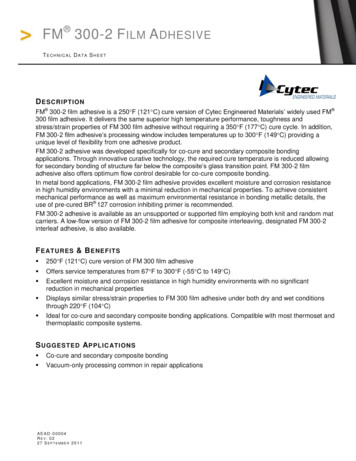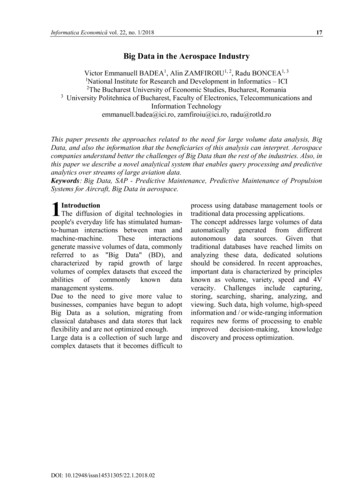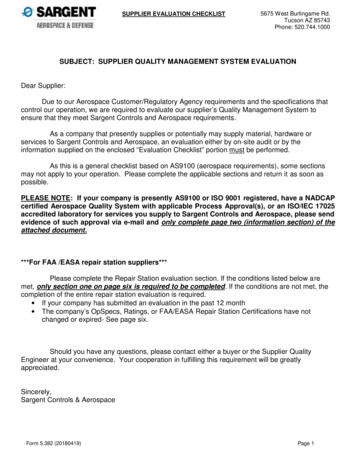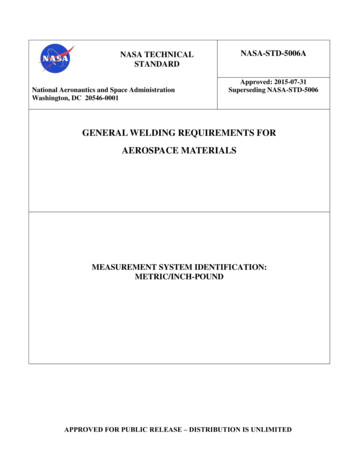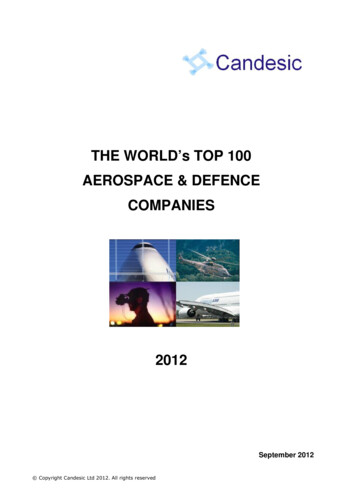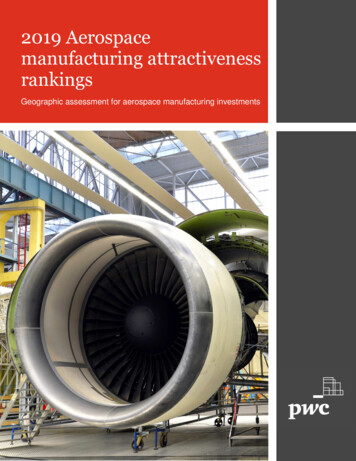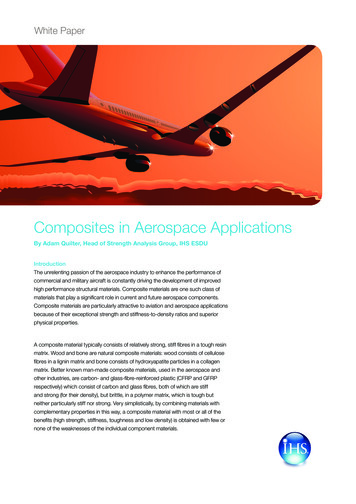
Transcription
White PaperComposites in Aerospace ApplicationsBy Adam Quilter, Head of Strength Analysis Group, IHS ESDUIntroductionThe unrelenting passion of the aerospace industry to enhance the performance ofcommercial and military aircraft is constantly driving the development of improvedhigh performance structural materials. Composite materials are one such class ofmaterials that play a significant role in current and future aerospace components.Composite materials are particularly attractive to aviation and aerospace applicationsbecause of their exceptional strength and stiffness-to-density ratios and superiorphysical properties.A composite material typically consists of relatively strong, stiff fibres in a tough resinmatrix. Wood and bone are natural composite materials: wood consists of cellulosefibres in a lignin matrix and bone consists of hydroxyapatite particles in a collagenmatrix. Better known man-made composite materials, used in the aerospace andother industries, are carbon- and glass-fibre-reinforced plastic (CFRP and GFRPrespectively) which consist of carbon and glass fibres, both of which are stiffand strong (for their density), but brittle, in a polymer matrix, which is tough butneither particularly stiff nor strong. Very simplistically, by combining materials withcomplementary properties in this way, a composite material with most or all of thebenefits (high strength, stiffness, toughness and low density) is obtained with few ornone of the weaknesses of the individual component materials.
CFRP and GFRP are fibrous composite materials; anotherjoints may be the weak points of a component — a rivetcategory of composite materials is particulate composites.needs a hole which is a stress concentration and thereforeMetal matrix composites (MMC) that are currently beinga potential crack-initiation site, and fewer fasteners anddeveloped and used by the aviation and aerospacejoints can mean a shorter assembly time.industry are examples of particulate composites andconsist, usually, of non-metallic particles in a metallicShorter assembly times, however, need to be offsetmatrix; for instance silicon carbide particles combinedagainst the greater time likely to be needed to fabricatewith aluminium alloy.the component in the first place. To produce a compositecomponent, the individual layers, which are often pre-Probably the single most important difference betweenimpregnated (‘pre-preg’) with the resin matrix, are cut tofibrous and particulate composites, and indeed betweentheir required shapes, which are all likely to be differentfibrous composites and conventional metallic materials,to a greater or lesser extent, and then stacked in therelates to directionality of properties. Particulatespecified sequence over a former (the former is a solidcomposites and conventional metallic materials are,or framed structure used to keep the uncured layersnominally at least, isotropic, i.e. their properties (strength,in the required shape prior to, and during, the curingstiffness, etc.) are the same in all directions, fibrousprocess). This assembly is then subjected to a sequencecomposites are anisotropic, i.e. their properties varyof temperatures and pressures to ‘cure’ the material.depending on the direction of the load with respect to theThe product is then checked thoroughly to ensureorientation of the fibres. Imagine a small sheet of balsaboth that dimensional tolerances are met and that thewood: it is much easier to bend (and break) it along acuring process has been successful (bubbles or voidsline parallel to the fibres than perpendicular to the fibres.in the laminate might have been formed as a result ofThis anisotropy is overcome by stacking layers, eachcontamination of the raw materials, for example).often only fractions of a millimetre thick, on top of oneanother with the fibres oriented at different angles to formThe Use of Composites in Aircraft Design1a laminate. Except in very special cases, the laminateAmong the first uses of modern composite materialswill still be anisotropic, but the variation in propertieswas about 40 years ago when boron-reinforced epoxywith respect to direction will be less extreme. In mostcomposite was used for the skins of the empennages ofaerospace applications, this approach is taken a stagethe U.S. F14 and F15 fighters.further and the differently-oriented layers (anything froma very few to several hundred in number) are stacked in aspecific sequence to tailor the properties of the laminateInitially, composite materials were used only in secondaryto withstand best the loads to which it will be subjected.structure, but as knowledge and development of theThis way, material, and therefore weight, can be saved,materials has improved, their use in primary structurewhich is a factor of prime importance in the aviation andsuch as wings and fuselages has increased. The followingaerospace industry.table lists some aircraft in which significant amounts ofcomposite materials are used in the airframe. Initially, thepercentage by structural weight of composites used inAnother advantage of composite materials is that,manufacturing was very small, at around two percent ingenerally speaking, they can be formed into morethe F15, for example. However, the percentage has growncomplex shapes than their metallic counterparts. Thisconsiderably, through 19 percent in the F18 up to 24not only reduces the number of parts making up a givenpercent in the F22. The image below, from Reference 1,component, but also reduces the need for fasteners andshows the distribution of materials in the F18E/F aircraft.joints, the advantages of which are twofold: fasteners andThe AV-8B Harrier GR7 has composite wing sections and2
the GR7A features a composite rear fuselage.was used for the elevator of the A310. Following theseComposite materials are used extensively in thesuccesses, composite materials were used for the entiretail structure of the A320, which also featured compositeEurofighter: the wing skins, forward fuselage, flaperonsfuselage belly skins, fin/fuselage fairings, fixed leading-and rudder all make use of composites. Toughened epoxyand trailing-edge bottom access panels and deflectors,skins constitute about 75 percent of the exterior area.trailing-edge flaps and flap-track fairings, spoilers,In total, about 40 percent of the structural weight of theailerons, wheel doors, main gear leg fairing doors, andEurofighter is carbon-fibre reinforced composite material.nacelles. In addition, the floor panels were made of GFRP.Other European fighters typically feature between aboutIn total, composites constitute 28 percent of the weight of20 and 25 percent composites by weight: 26 percentthe A320 airframe.for Dassault’s Rafael and 20 to 25 percent for the SaabGripen and the EADS Mako.The A340-500 and 600 feature additional compositestructures, including the rear pressure bulkhead, the keelThe B2 stealth bomber is an interesting case. Thebeam, and some of the fixed leading edge of the wing.requirement for stealth means that radar-absorbingThe last is particularly significant, as it constitutes thematerial must be added to the exterior of the aircraftfirst large-scale use of a thermoplastic matrix compositewith a concomitant weight penalty. Composite materialscomponent on a commercial transport aircraft. The useare therefore used in the primary structure to offset thisof composites enabled a 20 percent saving in weightpenalty.along with a lower production time and improved damagetolerance.The use of composite materials in commercial transportaircraft is attractive because reduced airframe weightThe A380 is about 20-22 percent composites by weightenables better fuel economy and therefore lowersand also makes extensive use of GLARE (glass-fibreoperating costs. The first significant use of compositereinforced aluminium alloy), which features in the frontmaterial in a commercial aircraft was by Airbus in 1983 infairing, upper fuselage shells, crown and side panels, andthe rudder of the A300 and A310, and then in 1985 in thethe upper sections of the forward and aft upper fuselage.vertical tail fin. In the latter case, the 2,000 parts (excludingGLARE laminates are made up of four or more 0.38 mmfasteners) of the metal fin were reduced to fewer than 100(0.015 in) thick sheets of aluminium alloy and glass fibrefor the composite fin, lowering its weight and productionresin bond film. GLARE offers weight savings of betweencost. Later, a honeycomb core with CFRP faceplatesFighter AircraftU.S.AV-8B, F16, F14, F18, YF23, F22, JSF, UCAV Harrier GR7, Gripen JAS39,EuropeMirage 2000, Rafael, Eurofighter, Lavi, EADS Mako MIG29, Su SeriesRussiaBomberU.SB2TransportU.S.KC135, C17, 777, 767, MD1 1 A320, A340, A380, Tu204. ATR42,EuropeFalcon 900, A300-600General AviationPiaggio, Starship, Premier 1, Boeing 787Rotary AircraftV22, Eurocopter, Comanche, RAH66, BA609, EH101, Super Lynx 300, S923
15 and 30 percent over aluminium alloy along with veryThe excellent strength-to-weight ratio of compositesgood fatigue resistance. The top and bottom skin panelsis also used in helicopters to maximize payloads andof the A380 and the front, centre and rear spars containperformance in general. Boeing Vertol used compositesCFRP, which is also used for the rear pressure bulkhead,for rotorcraft fairings in the 1950s and made the firstthe upper deck floor beams, and for the ailerons, spoilerscomposite rotor blades in the 1970s. Composites areand outer flaps. The belly fairing consists of about 100used in major structural elements of many moderncomposite honeycomb panels.helicopters, including the V22 tilt-rotor aircraft, which isapproximately 50 percent composites by weight. Theformability of composites has been used to particularThe Boeing 777, whose maiden flight was 10 ten yearsadvantage in helicopter manufacture to reduce theago, is around 20 percent composites by weight, withnumbers of component parts and therefore cost.composite materials being used for the wing’s fixedleading edge, the trailing-edge panels, the flaps andValidated Research Data to Improve EngineeringDesign, Performance and Methodologyflaperons, the spoilers, and the outboard aileron. They arealso used for the floor beams, the wing-to-body fairing,The ESDU (www.ihsesdu.com) Composites Seriesand the landing-gear doors. Using composite materials forprovides a collection of ‘Data Items’ and programs forthe empennage saves approximately 1,500 lb in weight.use in the design of fibre-reinforced laminated compositematerials. The information is provided primarily for use inComposite materials constitute almost 50 percent of thethe aerospace industry, but has wide application to otherBoeing 787, with average weight savings of 20 percent.areas of engineering where composite materials offersimilar design benefits. The ESDU Composites Seriescontains the solutions to many strength analysis problemsPercent of Structural WeightF/A-18C/D F/A-18E/FAluminumSteelTitaniumCarbon EpoxyOther49151310131003114211915100Increased CarbonEpoxy Usage in Centerand Aft FuselageCarbon Fibers (IM7) Usedin Wing and Tail SkinsHigh Strength/Durability(AERMET 100) Usedin Flap Transmissionsand elsewhereImproved Toughness Resin(977-3) Used in All C/EStructural Applications4
met in the design of fibre-reinforced laminated compositeConclusionsstructures. These applications include failure criteria, plateSo-called ‘conventional’ metallic materials and theirvibration and buckling, analysis of bonded joints, andderivatives continue to be developed and improved to offerstress concentrations, in addition to the calculation of basicever increasing performance, and there is no doubt thatstiffnesses and stresses, and built-in thermal stresses.they have a fundamental role in aerospace structures andLaminated composites can be specified in very many formsthe myriad applications in which they are employed. At theand assembled in a multitude of lay-up arrangements.same time, there is little doubt that the considerable benefitsBecause of this complexity the only practical form in whichoffered by composites have yet to be fully exploited and asmany of the solutions can be delivered is as computerknowledge and understanding grow, composite materialsprograms, and Fortran programs are provided for many ofwill play an increasingly significant role. This role will expandthe analysis methods. In addition to the flexibility to changenot only as a result of improved material performance, butthe overall geometry, a designer in composites can arrangealso as human ingenuity finds more and diverse areas wherethe material strength and/or stiffness to meet the localcomposite materials can be beneficially and advantageouslyloading. This complicates the design process and it is oftenemployed.difficult to select a route to the best combination of geometryand material. The ESDU Composites Series includesguidance on the factors influencing the design and suggestsSourcemethods of achieving the desired solution.[1] Mainly from Reference 1: “Low-cost composite materials andstructures for aircraft applications”, Deo, R.B., Starnes, J.H.,The ESDU Composite Series, which consists of 44 DataHolzwarth, R.C., May 2001.Items accompanied by 28 Fortran programs, encompassesthe areas summarized: L aminated composites – stress analysis, stiffnesses,lay-ups for special orthotropy, circular hole stress raiser,through-the- thickness shear stiffness, laminate design B uckling of balanced laminated composites – rectangularplates (flat/curved), panel with orthotropic stiffeners Buckling of unbalanced laminated rectangular plates S andwich panels with composite face plates – wrinklingof beams, columns, panels B onded joints – single- and multi-step lap,guide to design Plates under pressure F ailure criteria – failure modes and analysis, criteria, edgedelamination D amping and response to acoustic loading – dampingand rms (root mean square) strain in panels, fatigue lifeof element
Rotary Aircraft V22, Eurocopter, Comanche, RAH66, BA609, EH101, Super Lynx 300, S92. 15 and 30 percent over aluminium alloy along with very good fatigue resistance. The top and bottom skin panels of the A380 and the front, centre and rear spars contain CFRP, which is also used for the rear pressure bulkhead, the upper deck floor beams, and for the ailerons, spoilers and outer flaps. The belly .
